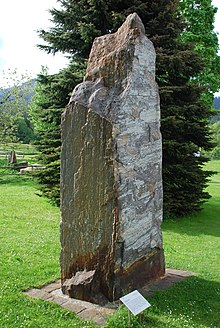Stainzer hard gneiss
The Stainzer hard gneiss is a building stone that is also known in Austria as Stainzer Platte or Stainzer Plattengneis , Stainzer Gneisplatte and in the Netherlands as Noricum . It is quarried near Stainz , but also in a number of other quarries in the Koralm area in Styria in Austria. It is a metamorphic rock , a transformation rock .

Emergence
The rock was created by a mountain pressure of 8 to 10 kilobars and a temperature between 550 and 645 ° C during tectonic movements in the course of the alpine mountain formation . It is also called gneissylonite because of its rolled-out layers. Its origin has been scientifically investigated; eight slab gneiss complexes have been documented in the Koralpen region.
Rock description and mineral inventory
Presumably it is an orthogneiss , although its appearance resembles the paragneiss . Its color is brownish-gray with white stripes. This gneiss shows a slate structure in which light and dark layers alternate. Layers of pegmatite containing other minerals also occur, e.g. B. garnet or tourmaline. Thin layers of eclogite or eclogite amphibolite, marble or calcium silicate lenses can also be included . The iron content means that if the rock is laid outdoors, it can take on a rust-red color after a few years.
The flat slate structure of this hard rock made of light quartz and dark biotite layers allows the extraction of 3 to 6 cm thick slabs, but slabs of any thickness can also be extracted.
Examples of the rock can be found in many places on the Koralpe and are exhibited with explanations in the Geopark Glashütten . The Prettner quarry near Gams is known as the type locality for the Stainz slab gneiss in the Gamser slab gneiss complex.
use
As a natural stone in Austria, this gneiss is mainly used outdoors for facing, wall stones , floor slabs , stair coverings and paving with split surfaces.
Only in a few cases has it been used in a polished form, for example on the buildings of the Dobl radio station near Graz.
The rock forms stacks of stone slabs called ovens as a result of weathering . Examples can be found in the middle Koralpe, such as the ovens on the Handalm , Osterwitz municipality. "Oven" is (next to the fireplace) a name for more or less jagged rocks or rubble that do not form mountains or other distinctive shapes. The word occurs frequently on the Kor and Saualpe, cf. Bärofen, large oven on the Koralpe, Mannagetta oven.
The platy gneiss obtained in the cadastral municipality of Oberwald near Ligist was used in a similar way and was called layer gneiss or Ligister plate gneiss .
literature
- Peter Beck-Mannagetta , Martin Kirchmayer: The quartz , mica and feldspar grain structures in the eight plate gneiss complexes of the Koralpe. In: Yearbook of the Federal Geological Institute . Volume 131. Vienna 1988. Pages 505-532 (PDF; 2.2 MB).
- Friedrich Müller : International Natural Stone Index (INSK). 10 vol. Ebner Verlag. Ulm 1987.
- Inge Wimmer-Frey: Structural and metamorphic investigations on the slab gneiss of the central Koralm, West Styria. Vienna 1984. Dissertation at the University of Vienna, faculty of formal and natural sciences.
- H. von Platen, Herbert Holler: Experimental anatexis of Stainzer slab gneiss from Koralpe, Styria, at 2, 4, 7 and 10 kilobars of H 2 O pressure. New Yearbook of Mineralogy - Treatises. 1966. E. Schweizerbart'sche Verlagbuchhandlung ISSN 0077-7757 . Volume 106. Pages 106-130.
- Haymo Heritsch: Excursion to the crystal in the Koralpe Institute for Mineralogy and Petrography at the University of Graz. Announcements of the natural science association for Styria. Volume 93, 1963. Pages 178-198 (PDF; 1.8 MB).
- Peter Beck-Mannagetta: On the tectonics of the Stainzer and Gamser slab gneiss in the Koralpe (Styria). Yearbook of the Federal Geological Institute . 90th year, Vienna. 1945. Pages 151–180 (PDF; 1.4 MB).
Individual evidence
- ^ A b August Hanisch, Heinrich Schmid: Austria's stone quarries . Carl Graeser & Co. Vienna 1901, pp. 94-95
- ^ A b Alois Kieslinger: Geology for building construction and plastic. Austrian commercial publisher. Vienna 1951, p. 155
- ^ A b c Walter Postl: Geopark Glashütten. A guide through the rocky world of the Koralpe. Publishing house of the Federal Geological Institute and the community of Gressenberg. Vienna / Gressenberg 2009. ISBN 978-3-85316-051-0 . Page 18.
- ^ Peter Beck-Mannagetta: Tectonics .
- ↑ Franz Pacher, Karl Riepl: About the chemical composition of gneiss and mica schist of the Koralpe. Announcements from the Natural Science Association for Styria. Volume 108, Graz 1978. pp. 45-54. (PDF; 2.3 MB)
- ↑ Peter Beck-Mannagetta, Martin Kirchmayer: Korngefüge , pages 506, 520-530.
- ^ Müller: International natural stone index. Rock no. 10.3.10 (see literature)
- ↑ Guided tours and specialist excursions 1970. B. 16th hiking conference of the Geological Society in Vienna: "Tertiary, volcanism and the edge mountains of southern Styria." (PDF; 2.3 MB) Peter Beck-Mannagetta: Explanations for the excursion day May 9, 1970. Communications of the Geological Society in Vienna. 63rd volume. Vienna 1970. p. 284.
- ↑ Jakob and Wilhelm Grimm: German Dictionary . Volume 13 N-Quurren. Leipzig 1889. Keyword “oven” point 6). Column 1158, line 21: The word is treated there for the Bavarian-Austrian mountain mouth as common Germanic for rock cave, fissured rock, jumbled rock debris (roots as far as Sanskrit ).
- ↑ Mannagetta furnace 46 ° 55 '45 " N , 15 ° 10' 28" O .
- ^ Felix Karrer: Guide through the building materials collection of the Imperial and Royal Natural History Court Museum . Vienna 1892, p. 122



